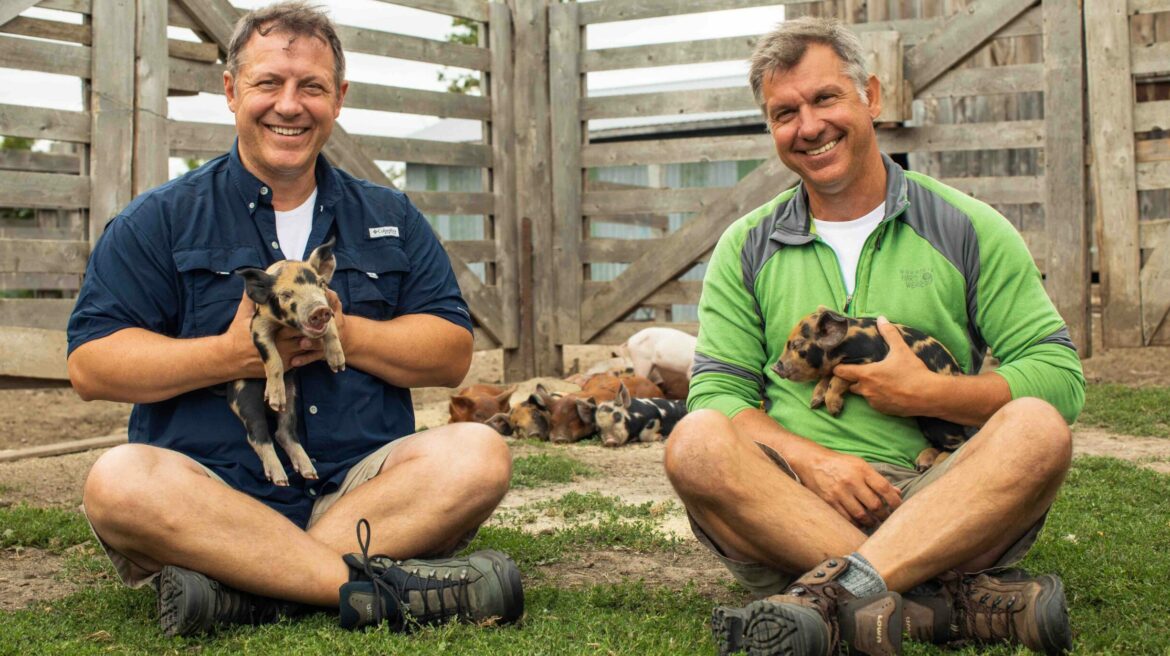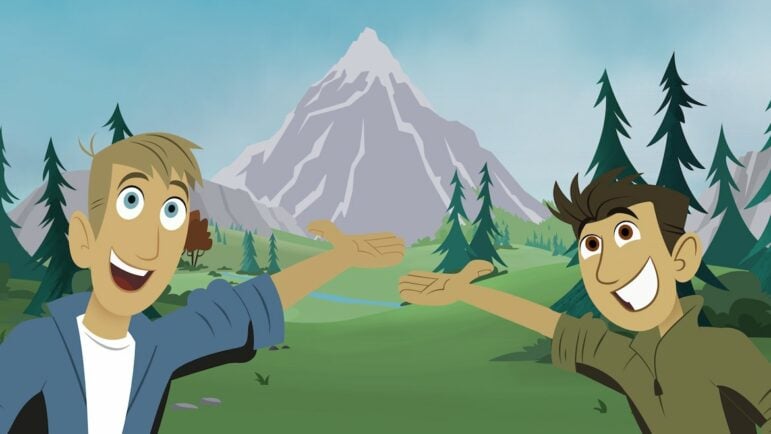Science behind ‘creature powers’ gives ‘Wild Kratts’ many angles for exploring the lives of animals

Courtesy of Kratt Brothers Company Ltd.
The Kratt brothers Martin and Chris in a live-action segment with piglets.
The Kratt Brothers’ unabashed love for wildlife, biology and science has been evident in all of their PBS Kids shows. But Wild Kratts, the series that has grown into an international multimedia property over the course of seven seasons on the air, lets them show the most of the natural world to their viewers.
With animation loosely inspired by legendary graphic artist Charley Harper, Wild Kratts has made the impossible possible, allowing viewers to shrink down to bug size with brothers Chris and Martin Kratt, swim with vampire squid in deep ocean waters, and quickly zoom to every continent (except Antarctica!) on a search for different owl species.
The television series has banked about a decade of live-action animal footage, which the brothers use to introduce the show’s concepts. “Now that we’ve built … a library of different animals and different assets and different habitats,” Chris Kratt says, “we’re able to look at the natural world in a few different ways.”
Some shows in the 20-episode season are devoted to animal classification. Others focus on the different roles of animals in the wild, such as predators versus prey. One looks at the boundary-breaking mudskipper, a fish that actually spends much of its time on land.
“We want to be honest with the audience,” Chris Kratt says. “We teach about science and … natural history, but we like to look at animals not as objects but … as if they’re fellow creatures. We like to try and understand them, just like we would try to understand a human friend. What are they afraid of? What are their challenges? What do they really like to do? What’s their favorite food? All the stuff that you would ask a friend when you’re getting to know them.”
The team takes special care to do up-to-the-moment research on each animal featured in the series, Kratt says. “We try to identify what each animal does better than any other creature on Earth,” he says. “Then we figure out what science concept allows that animal to have that creature power. … All those things need to be wrapped up in a … narrative in a way that is age-appropriate for a kid to learn and digest.”
Wild Kratts takes this holistic approach out of the belief that kids can handle big concepts as long as they’re explained in a way that interests them, Kratt says. “Kids like to be told a good story, and they like good characters,” he says. “They’re also curious, and they really get excited about learning new things.”
‘True educators’
The Kratts use animals and nature to teach bigger STEM concepts to kids. “We can explore the concept of gravity by looking at peregrine falcons because they fall from the sky like a rock and harness the force of gravity to reach speeds of 220 miles per hour,” Kratt explains.

While it’s true that an 8-year-old might get the concept of gravity more clearly than a 4-year-old, there’s lots to love across the show for all ages. Viewers can grow and change along with Wild Kratts, a characteristic that helps explain why it’s been such a long-running success for PBS Kids.
“The Kratt Brothers are the real deal,” Sara DeWitt, SVP and GM of PBS Kids, said in a statement. “They have the degrees and field expertise to be true educators — and this passion and excitement comes through in all of their content for kids.”
The brothers have “done a fantastic job of inviting kids to experience their creature adventures through gameplay,” she added.

Chris and Martin Kratt have been entertaining and educating kids on PBS for more than 25 years — long enough that the kiddos who watched their first shows are now grown adults. Their star power began growing with the 1996 PBS Kids premiere of Kratts’ Creatures. Lemur-loving Zoboomafoo was a staple of the children’s lineup from 1999 to 2001.
With the premiere of the first batch of shows from its seventh season, Peabody-nominated Wild Kratts extended its run on PBS Kids to 12 years, bridging generations of viewers, cultural shifts and the revolution of digital technology. Now airing in 32 countries, the series has been nominated for Peabody Awards and multiple Daytime Emmys, all while expanding from broadcast to digital platforms and live performances.
Last month, Hollywood Reporter named the brothers to its list of “The 75 Most Powerful People in Kids’ Entertainment.” And — wouldn’t you know — Kratt confirms that plans for a movie have been “percolating” for years. But of course he can’t say anything more about that right now.
“We’ve had such a great relationship with PBS over the years,” Kratt says. “I think it’s because we share the same sensibilities and the same goals. We all want to empower kids with knowledge and with the sense that they can learn about the world around them. We try to spark their curiosity, too, and we’ve made it our mission to try to do whatever we can to help kids grow and develop.”
With 16 more episodes left to air in Wild Kratts’ seventh season — including the series’ 200th — there are plenty more creature adventures to come. New episodes will premiere on PBS Kids through 2025, according to DeWitt, who adds, “We do not have an update on season 8 at this time.”
‘Imagine what you can do’
Deborah Hamlett, VP and GM of Milwaukee PBS, praises Wild Kratts for its accessibility and relevance to kids growing up in urban landscapes or rural outposts.

“The show talks about things that kids are seeing in their own backyard,” says Hamlett. “You don’t have to be looking at a polar bear. You can see something nearby and say, ‘I want to jump and fly like that grasshopper, like I saw on Wild Kratts.’ This show helps you imagine what you could do if you had wings like an eagle.”
The Kratts’ choices to devote episodes to animals that thrive in urban environments, including crows or the aforementioned peregrine falcon, intentionally remind viewers that “nature is accessible to all of us, no matter where we live,” Kratt says. Those episodes reinforce the idea of looking for nature in what’s near you.
Wild Kratts is solidly among the top five most popular PBS Kids shows across station broadcasts, cross-platform streaming, YouTube views and games played on the PBS Kids portal, according to audience metrics for September 2022 to April 2023 provided by PBS. Nielsen data from 2021 shows that the series has cross-generational appeal. About 40% of young Wild Kratts viewers co-watched with an adult.
The Kratts will be hitting a lot of urban and suburban environments on their 16-city upcoming tour, which kicks off Sept. 15 in their adopted hometown of Ottawa, Ontario. “Wild Kratts Live! 2.0 Activate Creature Powers” will criss-cross the Eastern and Midwestern U.S. this fall and hit Western states in 2024.
After the brothers perform a live version of Wild Kratts on stage, they take time to meet and greet fans, who often bring them ideas for new episodes. Their team works on local promotions with PBS member stations along the tour route, Kratt says. Sometimes they’ll record on-air promos for stations. They also invite stations to set up a booth at the live show “so that they can connect more fully with the audience and let them in on some different things that they’re doing,” he says.





